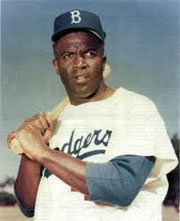
Jackie Robinson: “Too bad he’s the wrong color”
By Lee A. Daniels
You could say “42,” the film about the life of Brooklyn Dodgers great Jackie Robinson, is a gripping baseball tale, and your assessment would be correct – but woefully incomplete.
“42” is not just a baseball story. It’s a compelling history lesson as well. It tells the story of not just baseball, but of a central facet of 20th Century American life – the suffocating reach of racism – in the decades before the 1960s.
It conveys the grievous wrong Black Americans endured and signals what it cost them, and America as a whole. And it indicates how the barrier of racism was cracked by Blacks and whites who worked – many over the course of decades – to destroy it.
“42” reminds us, as the Major League’s season gets underway, that, given its mythic status in American life, baseball’s most important milestone had nothing to do with the mechanics of playing the game or a particular game that was played but with cleansing the moral center of American democracy itself. It recounts once again in popular form the story of a man whose life proved that history sometimes acts through individuals and individuals can act to influence history.
“42” tells a story that never gets old; for it is rooted in the saga of an America that once was, and then began to change sharply – a change which has yielded enormous benefits but which also remains both incomplete and resisted.
Jack Roosevelt Robinson, born in 1919, grew up in an America where the words “Too bad he’s the wrong color” were often the kindest remarks white Americans would say about Black Americans.
A Boston Red Sox scout said them in April, 1945 during the now-infamous sham tryout at which that storied team passed on signing the future Hall of Famer despite his impressing Sox officials with his hitting and fielding. (A few years later, the Sox would also pass on signing Willie Mays. They would be the last team in baseball to add – in 1959 – a Black player to their roster.)
Of course, the scout was wrong. As would become evident two years later, beginning on April 15, 1947, Jackie Robinson was the right color, and of the right character, after all, to help ratchet up the pressure that had been building for decades among Black Americans in the North and South to confront the country’s great sin. To repeat, that wrong wasn’t merely Blacks’ 50-year exclusion from the playing fields of Major League Baseball.
Even as white America was boasting that its victory over Germany and Japan in World War II had made the world “safe” for democracy, Black Americans could see in every sector of American society – higher education, the movie industry, the civil service, residential housing, the military, large corporations and small businesses alike, the labor unions, collegiate and professional sports, and so on – that bigotry, not democracy, was triumphant.
The South’s apartheid system had its explicit “Whites Only” and “No Colored Allowed” signs. But, although the signs were absent, the same noxious sentiments existed almost everywhere in the North and West, from Boston to Pasadena, Calif., where the Georgia-born Robinson grew up.
In the immediate postwar environment, Robinson’s signing by the Branch Rickey-led Dodgers was the thunderclap that heralded the massing of new forces in the domestic fight to make America itself safe for democracy.
By then, Black Americans had the diverse organizational strength at the national and local levels to field multiple challenges to racism. By then, a still very small but growing number of white organizations – and individuals like Branch Rickey – were actively looking for ways to break the numerous “color barriers” that characterized American society. And by then, America’s position of global leadership was beginning to exert pressure on it to live up to its boasts about loving freedom by extending it to Black Americans, too. It was no accident of history that within a year of Robinson’s breaking baseball’s color barrier President Truman ordered the desegregation of America’s other signal mythic institution – the military.
Jackie Robinson’s story was but one facet of the diamond of Black determination that in the 20 years after World War II would dismantle the legalized structure of racism. But he – an extraordinarily-gifted, fiercely-competitive athlete who possessed a deeply spiritual, disciplined character – was superbly suited for the challenge he, and America, confronted.
The wrong color? Not on your life.
